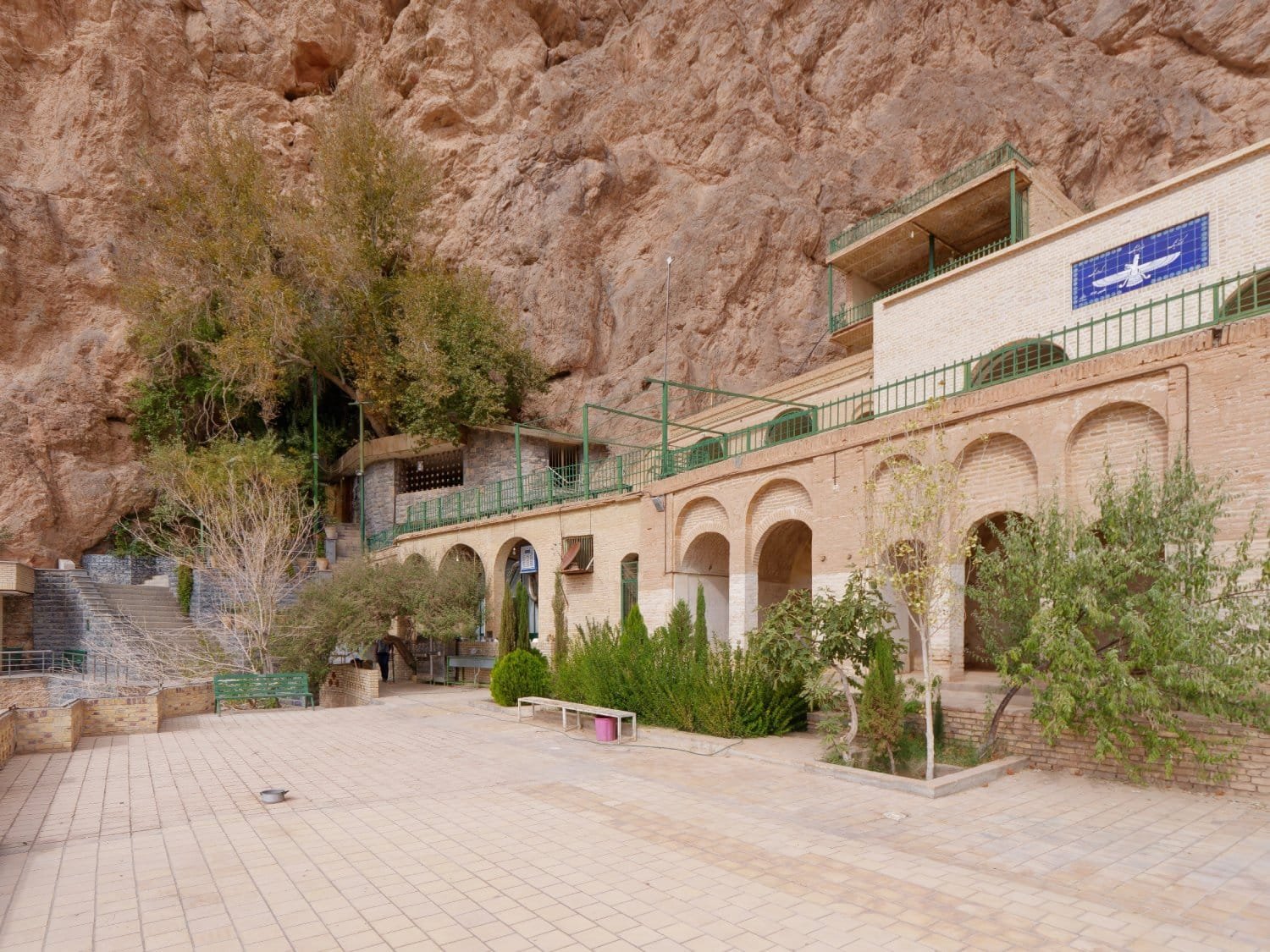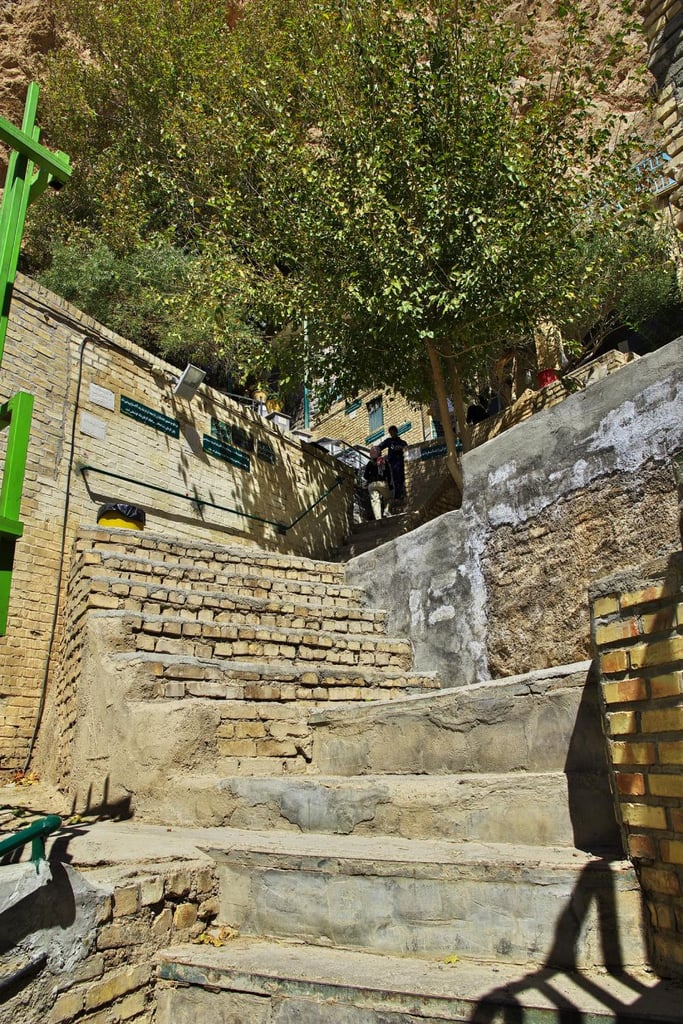
Chak Chak, also known as Pir-e Sabz, stands as a crucial pilgrimage site for Zoroastrians. It symbolizes the unity of the Zoroastrian community. Located in the Chak Chak mountains, this shrine is one of Yazd‘s most intriguing attractions. Its mysteries and legends add to its allure, yet it remains somewhat unknown and enigmatic.
Contents
Geography and Architecture

Chak Chak’s geographical location and significance among Zoroastrians make it a fascinating destination for travelers. Its mysterious aura, unique architecture, and location in the heart of a mountain in the desert amplify its appeal.
A unique feature of this shrine is water dripping from the ceiling, supporting the growth of an ancient plane tree and other plants like myrtle, Persian Ironwood, and mountain figs on its rocky surface.
Location of Chak Chak on Google Maps
Religious Importance
Besides its religious importance to Zoroastrians, Chak Chak distinguishes itself from other Zoroastrian shrines due to its natural water source and trees. The efforts of Zoroastrians, both within and outside Iran, in constructing, maintaining, and preserving this site cannot be overlooked.
Ceremonies at Chak Chak Shrine in Yazd

As a religious hub, Chak Chak hosts Zoroastrians from Iran and abroad during specific times of the year for collective religious ceremonies.
One such ritual occurs from June 14th to 17th (24th to 27th of Khordad), drawing Zoroastrians for prayer, communal worship, reading of the Avesta, invocation of Ahura Mazda, cooking votive meals, lighting candles and incense, and singing joyous hymns. The grandeur of this ceremony is so significant that it’s referred to as the Zoroastrian Hajj.
Mehregan Festival
Another gathering occurs during the Mehregan festival, where Zoroastrians assemble at Chak Chak, dressed in purple for six days of celebration and dancing. Sizdah Be-dar is a special day where only Zoroastrian followers are allowed entry into the shrine.
Interestingly, similar to followers of other religions who consider their shrines sacred, Zoroastrian brides and grooms also start their new life by visiting this shrine to seek blessings.
The Mysterious History of Chak Chak Shrine
Chak Chak Shrine’s history remains a topic of debate among historians and religious scholars. However, efforts by Mr. Rostam Belivani, former head of the Sharifabad Yazd Zoroastrian Association, are evident in an inscription at the shrine’s entrance, summarizing its history.
Formation of the Shrine
According to the collected information, the shrine’s formation dates back to around 1370 years ago, following the death of Yazdegerd III, the last Sassanian king. Legends suggest its creation was influenced by the disappearance of Yazdegerd’s daughter. A shepherd, along with Zoroastrian elders, is said to have initiated its construction.

Chak Chak as a Zoroastrian Pilgrimage Site
Today, Chak Chak Mountain is a sacred site for Zoroastrians, rooted in the religion of Iranians during the Sassanian era when Zoroastrianism was the official religion. The shrine holds a special place for Zoroastrians due to their involvement in its construction and maintenance.
Incredible Legends of Chak Chak Shrine
The mysterious and unknown history of Chak Chak is one of its most fascinating aspects. Various legends exist, but it’s unclear which, if any, are closest to reality.
Chak Chak as Pir-e Sabz
Pir-e Sabz, another name for the shrine, combines material and spiritual elements. The term “Pir” refers to the final step in Mithraism worship, while “Sabz” (green) signifies the presence of an ancient plane tree at the site.
Temple of Anahita

Historical records suggest that Chak Chak resembles the temples of Anahita. These temples, often built on high grounds with flowing water, share similarities with Chak Chak, including their east-facing construction for sun worship.
Role of Yazdegerd’s Daughters in the Shrine’s Formation
Legend narrates that during the chaotic Arab invasion and fall of the Sassanian dynasty, Yazdegerd III sought refuge in a safe region, now known as Yazd. His daughters fled to the surroundings of Yazd, each facing different fates. One daughter, Nikbanu, disappeared near the Chak Chak mountain.
The Mysterious Disappearance of Nikbanu
An interesting tale surrounds Nikbanu’s disappearance. As the story goes, she sought refuge in the mountain from pursuing enemies. The mountain miraculously opened up to hide her, leading to a spring emerging from its crevices.
Shepherd’s Dream and Shrine Construction
A shepherd, in search of his lost sheep, discovered the water source. In his dream, a lady, believed to be Nikbanu, instructed him to build a shrine and light candles there. This dream led to the construction of the Chak Chak Shrine with the help of Zoroastrian elders.
The Ancient Plane Tree’s Legend
The thousand-year-old plane tree at the site is thought to be Nikbanu’s staff, which, according to legend, turned into the tree after touching the mountain crevice.

The Two Important Considerations
Finally, it’s worth noting that most Zoroastrian prayer sites predate the Sassanian era and there’s no historical mention of Yazdegerd III’s children fleeing to this location. These factors suggest other theories about the shrine’s origin might be more credible than those involving Yazdegerd’s children.
Why is the Zoroastrian Shrine Named Chak Chak?
The name “Chak Chak” for this Zoroastrian shrine comes from the sound of dripping water from the rocks, reminiscent of a ‘drip-drip’ sound. This water is significant as it is the main water source for the Chak Chak Shrine in Yazd.
Terraced Architecture of Masuleh in Chak Chak

Upon reaching Chak Chak Mountain, visitors see a five-story structure built in a staggered, terraced fashion, where the roof of one level serves as the courtyard for the next. These rooms, known as “Khileh,” are used for the rest and accommodation of Zoroastrian pilgrims. The oldest room, dating back to the era of Naser al-Din Shah, is approximately 150 years old.
Inside one of these rooms is a well, considered sacred by Zoroastrian followers. Pilgrims tie a thread around its rope to fulfill their wishes.
Adjacent to these rooms, a kitchen and oven are built for the convenience of pilgrims to cook and offer their sacrificial lambs.
Visiting the Shrine as a Non-Zoroastrian

Non-Zoroastrian visitors can explore the shrine but cannot stay overnight in these rooms. As you ascend the stairs towards the shrine’s higher levels, you’ll see inscriptions from the Zoroastrian holy book, the Avesta, on the rocks, including phrases like “In the world, there is only one path, the path of salvation.”
At the top, a beautiful, golden-colored door adorned with the image of a spear-wielding Achaemenid soldier marks the entrance to a stone building resembling a cave’s mouth. Upon entering, after removing shoes, visitors step on the marble stones of the fire temple. Since the temple is nestled within the mountain and water drips from certain areas, the floor remains damp and cool.
Inside the fire temple, there’s a wall between two stone boulders designated for candle lighting. In front of it stands the Zoroastrian eternal flame, surrounded by tear-shaped vessels for lighting candles and incense, forming a lotus flower pattern. Zoroastrians light candles and incense here for prayer.
The darkened, smoke-stained walls, a result of the perpetual fire, and an ancient plane tree emerging from the rocks, recognized as a natural heritage of Iran, capture attention. Looking up, you’ll see a stone ceiling with a chandelier for illumination and a part where water drips, collected in vessels for drinking and blessing purposes.
Number of Steps to Chak Chak

To reach the Pir-e Sabz Shrine nestled in the mountains, visitors must ascend a path. For safety, 360 steps have been constructed along the winding path leading to the shrine. Hence, visiting Chak Chak is not recommended for those with heart or respiratory issues, mobility impairments, or anyone who might struggle with climbing these many steps.
Scientific Explanation of Water Dripping
The water seeping from Chak Chak mountain has been scientifically explained by Dutch geologists. They discovered that the mountain sits on an underground fault line about one kilometer deep. An underground water channel, upon encountering this fault, gets redirected upwards due to high pressure. The limestone composition of the mountain allows this water to percolate out.
Facilities Limitation at Chak Chak Shrine
The Chak Chak Shrine has limited facilities, offering only electricity, water, toilets, and rooms specifically for Zoroastrians. Therefore, visitors should bring any necessary items from the nearby cities of Yazd or Ardakan.
Visiting Etiquette at Chak Chak Shrine
Just as mosques are open for visitors of other faiths, Chak Chak Shrine is also accessible to tourists of different religions, promoting cultural and religious understanding. Visitors should maintain cleanliness, remove shoes, and wear appropriate attire like head coverings. Invitation cards are required for specific Zoroastrian ceremonies, and non-Zoroastrians are not permitted during certain events.

Best Time to Visit Chak Chak
The ideal time to visit Chak Chak is during cooler months like autumn (October and November) and spring (April and May), considering the desert climate and the challenge of climbing 360 steps in the heat. Avoid visiting during religious events unless invited.
Location of Chak Chak Shrine
Address: Northwest of Yazd, Iran, 43 kilometers east of Ardakan, in the Khavaranq district.
Access Route to Chak Chak
The shrine is nestled between the Ardakan and Anjireh mountains in the Chak Chak mountain range, a well-known spot between the people of Yazd and Kerman. From Yazd, it’s a 96-kilometer journey, while from Ardakan, it’s a 43-kilometer trip.
Chak Chak Shrine in Brief
We discussed various aspects of the Chak Chak Shrine, including its geography, history, the role of a Sassanian princess in its formation, and its significance to Zoroastrians, despite lingering mysteries about the site.





